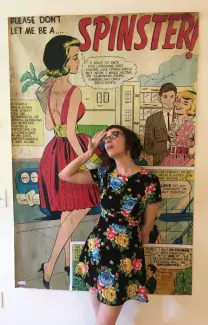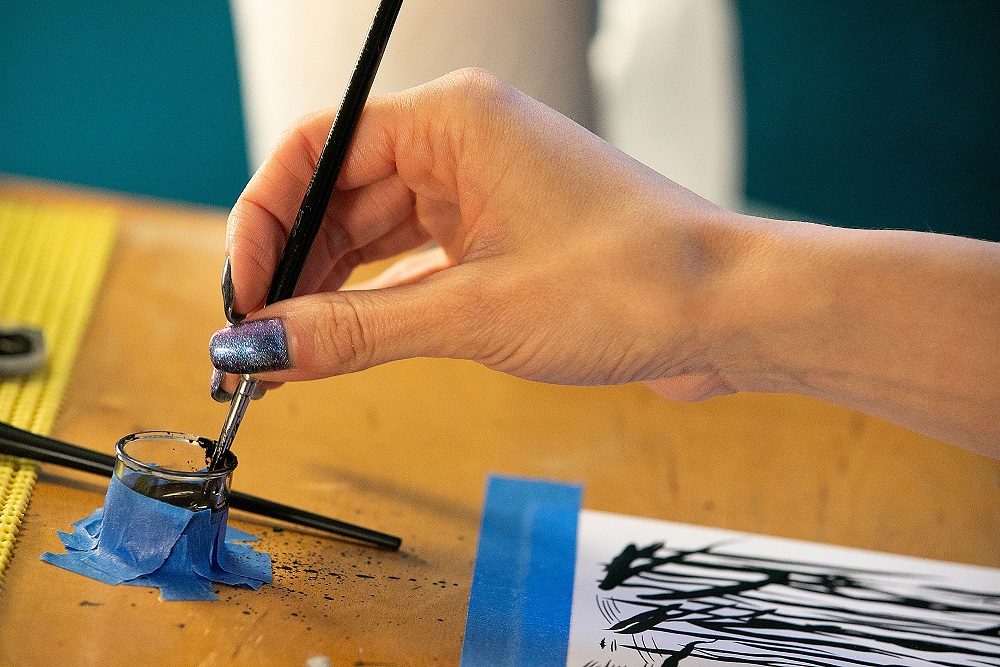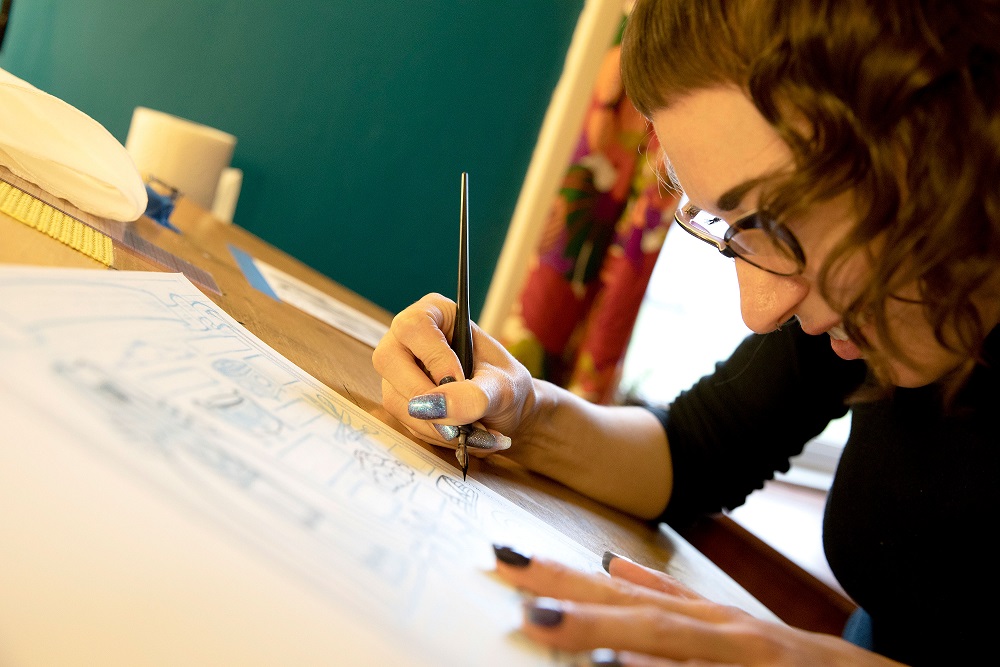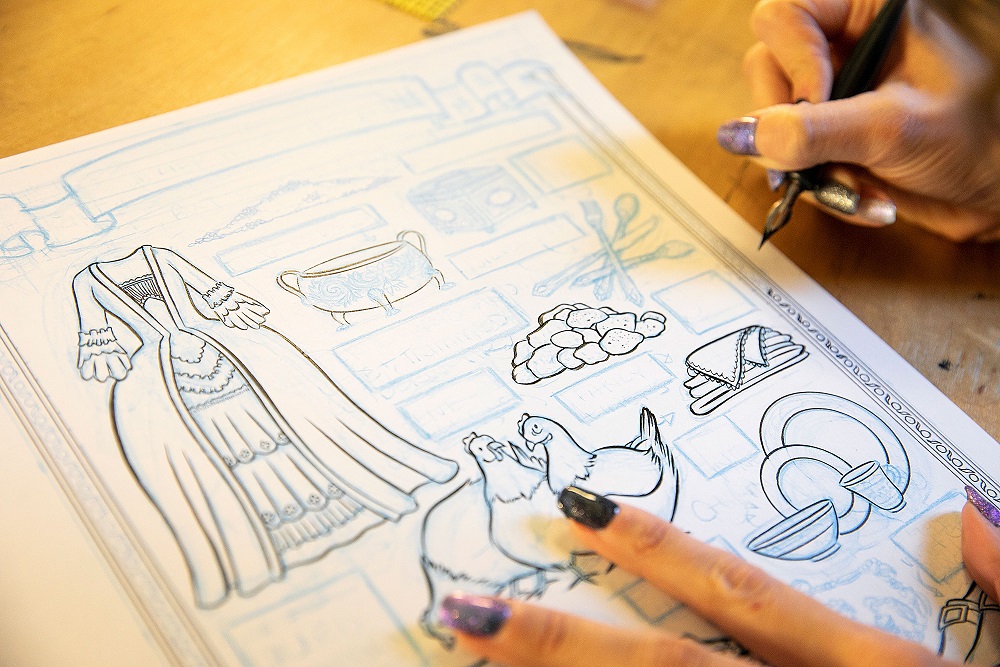
CCAD Stories: Emi Gennis

Emi Gennis’ comics origin story is a bit different than most.
“Most cartoonists have been drawing since they came out of the womb; they always knew they wanted to make comics,” said Gennis, the newest faculty member in Columbus College of Art & Design’s newest major, Comics & Narrative Practice.
Gennis, however, came to the practice later in life, when the University of Chicago student was required by her art history major to take a deep dive into a thesis topic over the course of two years. Comics, she figured, could hold her attention. “But I could’ve easily chosen something else,” she said.
Fortunately, she did not. She dove into comics theory and comics history (and comics themselves). Then, in her final quarter, she signed up for a class with comics scholar and artist Ivan Brunetti.
“I thought, ‘This ought to be fun. I’ve been reading about comics for a couple of years,’” Gennis recalled. “I’d never taken a drawing class, but I understood the language of comics because I’d been reading so much comics theory. Afterward, I approached my professor and asked, ‘So, how do I do this for real?’ And then I spent the next two years making comics.”
Gennis went on to earn her MFA in Sequential Art from Savannah College of Art & Design, interned at a Portland, Oregon, comics studio, and began creating her own nonfiction comics and illustrated books. Her work has been included in publications such as The Hairpin and The Nib, and her autobiographical story, Baseline Blvd, was nominated for Slate's Cartoonist Studio Prize.
Gennis taught at Pittsburg State University in Kansas before joining Columbus College of Art & Design in 2017 as Assistant Professor of Comics & Narrative Practice.
“I have my dream job—one I've been working toward for my whole life. I'm still kind of in awe of it,” she said. “My students are great and I couldn't ask for anything better. I'm living my best life right now.”



Teaching at the college level was always your Plan A. Can you talk about why you love it and what you’re working on now?
I really like working with young people, and it’s exciting for me to see my students grow both as artists and as people. I think a lot of art advice is also life advice. Like for example, it’s okay to make mistakes—in fact, it’s important to make mistakes! That’s how we learn to make better choices, in our work and in general. To see that growth and change in my students, and to have the privilege of playing a role in it, is really moving. I get kind of sentimental about it sometimes. I tear up at graduation every year.
I’m currently teaching Character & Environment Design, Comic Book Illustration, and Comics & Narrative Illustration 1. In the spring, I’ll teach Comics & Narrative Illustration 2, Illustrative Lettering, and Self Promotion for Illustrators. I’m particularly excited to teach self promotion because I feel very strongly that business skills are just as important for our students to learn as art skills. It’s very important to me to dispel the myth of the “starving artist.” I talk to my students about navigating finances, how to read a contract, how to advocate for themselves with editors and clients, how to deal with the pitfalls of freelancing, how to negotiate, price work, and do fundraising. I also try to connect them with opportunities for grants and residencies.
Another important part of the business aspect of being an artist is networking, which can be really scary when you’re first starting out! A huge strength of our program is that (Assistant Professor of Comics & Narrative Practice) Laurenn McCubbin and I are well acquainted with many professionals in both the alternative and mainstream comics industry, and that allows us to create opportunities for our students to make those connections.
What is the comics community like in Columbus?
A large part of why I was excited to come to Columbus is the Billy Ireland Cartoon Library & Museum. We’re so fortunate to have the largest collection of original cartoons and comic art right here in town. It’s an amazing resource for my students that I wouldn’t have anywhere else, so I feel very lucky to be teaching here. The Billy Ireland also brings a lot of people through town. Many cartoonists, obviously, but also scholars, critics, librarians, editors, and other people who work in the comics field. There are lots of events that take place at the Billy Ireland, Kafe Kerouac, and Laughing Ogre, as well as local conventions like SPACE and Cartoon Crossroads Columbus, that are all great opportunities to meet other comics folks and creates a strong sense of community.

Photos taken by Ty Wright for CCAD. Top photo taken by Gennis' mother, Christine Cahill.
Can you talk a bit about your personal practice?
My work has been exclusively nonfiction for basically my whole career. Mostly, I make history comics, but I’ve also done some journalism comics and occasionally memoir. Lately a lot of my work has centered around people reaching for greatness and falling short. Like the story of the woman who was the first person to survive going over Niagara Falls in a barrel, hoping it would bring her fame and fortune, which it didn’t. Or the man who set out to prove the existence of the afterlife through an “experiment” that involved him committing suicide and attempting to make contact with the living from the beyond. Or the adventurer who was determined to reach the North Pole in a hydrogen balloon (spoiler: it goes badly!).
Some of the comics I’ve worked on are really sad stories, but I think important stories to tell. Several years ago I worked on a piece about the Radium Girls, who were a group of women that worked in a clock factory painting radium on the clock faces so that the numbers would glow in the dark. No one told them that the radium was dangerous, and in fact, they were encouraged to tip their paint brushes on their tongues, which caused them to ingest a fair amount of it. Many of them got very sick and died extremely young. Their lawsuit against the company is an important landmark in the labor rights movement.
As a storyteller working with history, I try to think a lot about what stories get told and why those stories are presented the way that they are. Part of my own growth as an artist has been to recognize the responsibility that comes with representing history in my work. At this stage of my career I try to be very deliberate in the way I choose which stories to tell, if comics is the best medium to present a particular story, or whether some stories are worth telling at all.
Find more about Emi Gennis and her work on her website, Instagram, or Twitter.
Learn more about Comics & Narrative Practice at CCAD or apply here.
Post date
December 7, 2018